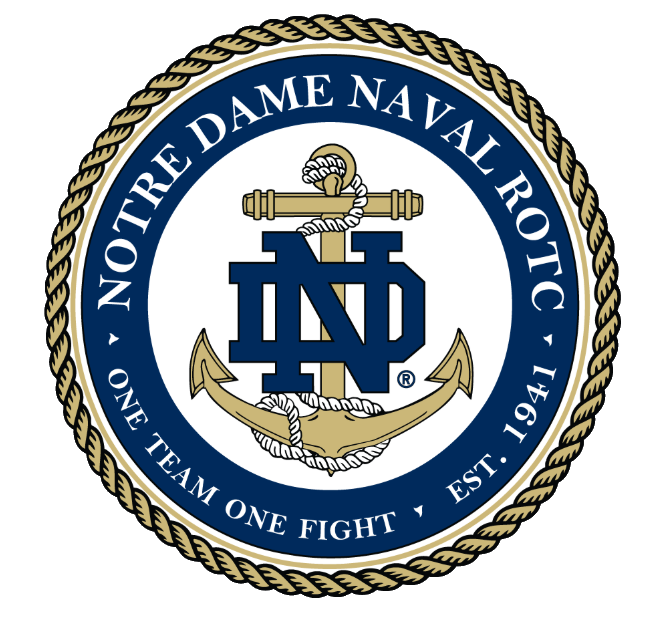Naval ROTC Program
Congressional legislation created the Naval Reserve Officers Training Corps in 1925. In 1932, the Marine Corps started offering Second Lieutenant commissions to NROTC graduates. With World War II imminent, President Roosevelt declared a state of national emergency in September 1939. Congress then authorized a large increase in the NROTC program, bringing the enrollment to 7,200 midshipmen and creating eighteen more units in the following two years. During the war, the V-7 and V-12 programs supplemented the NROTC program in training officers. These two programs were discontinued as the war drew to a close, but the NROTC program remained. In 1945, the Holloway Plan further increased the size of NROTC enrollment to 15,400 midshipmen to meet the demand for regular officers in the post-war Navy. This plan consisted of Scholarship and College Program students and has remained largely intact to the present day.
Notre Dame and the Navy
The University has had a long association with the military. In 1858, a student named William B. Lynch received Father Edward Sorin’s approval to organize a military company for the students, and in 1859 the “Continental Cadets” were formed. On Christmas Eve 1862, three Holy Cross sisters boarded the U.S. Navy’s first hospital ship, the Red Rover, to serve as nurses for the wounded on both sides of the war. They traveled the Mississippi River carrying sick and wounded soldiers to various military hospitals. In so doing they became what U.S. naval history today hails as the forerunners of the United States Navy Nurse Corps. Holy Cross priests served as chaplains in the Civil War and in World War I. Overall, more than 2000 Notre Dame men fought in World War I, 46 of whom were killed in action.
The association between the University and the Department of Navy began in September 1941 with the formation of an NROTC unit under the command of Captain H. P. Burnett. The program offered a four-year course in naval science and tactics which led to a reserve commission. It did not pay tuition and often did not entail active duty service after commissioning. For the Unit’s first celebration of Navy Day, Admiral C. W. Nimitz spoke at Washington Hall.
As the U.S. entered the war, many changes occurred. Studies were accelerated for all students enabling them to finish their degrees in three years or less. The Navy expanded its officer training at Notre Dame, beginning in February 1942, with the V-7 program. Under this program, officer candidates were indoctrinated at Notre Dame and continued their training at Abbott Hall, Chicago, Illinois, or on the USS PRAIRIE STATE, anchored in the Hudson River.
In September 1942, Notre Dame became a Midshipman Training Center, one of four in the nation (the others were in Chicago, New York City, and Annapolis.)
Midshipmen completed four months of training before receiving a commission. In January 1943, 1100 ensigns graduated from the program and became the first group of officers to receive all their training and be commissioned at Notre Dame. One of these graduates was the Medal of Honor recipient, Ensign John Joseph Parle. As the Allies were about to commence the invasion of Sicily in July 1944, “…an accidentally ignited smoke pot was about to touch off a boat laden with high-explosive charges and ammunition, which would disclose to the enemy the assault about to be carried out, he unhesitatingly entered the craft, snuffed out some burning fuses, and after failing to extinguish the smoke pot, took it in his bare hands and tossed it over the side, succumbing a week later as a result of the poisonous fumes and the smoke inhaled; he was awarded the Medal of Honor. Ensign Parle’s heroic self-sacrifice prevented grave damage to the ship and personnel and ensured the security of a vital mission. He gallantly gave his life in the service of his country.” (From the Dictionary of American Naval Fighting Ships) The USS Parle (DE-708) carried his name from 29 July 1944 until her disposition on 27 October 1970.
In 1943, the Navy further expanded its officer accessions with the V-12 program. This program offered two, 16-week semesters of academics, followed by further studies and training depending on the officer’s specialty. Aviators went directly to flight training. Engineering and deck officer candidates completed more studies before continuing their training. With the V-12 program, Notre Dame acquired a Marine detachment under the leadership of Captain John W. Finney, USMCR. During this time, the NROTC program remained active, graduating its first class in February 1944.
As a result of such extensive involvement with the Navy, Notre Dame’s student body had a large military relationship in World War II. In 1944, for instance, there were 2610 students enrolled; 1771 of which were in the military, 639 were civilians, and 200 were students of religion. During the war, Notre Dame trained nearly 12,000 naval officers.
As the war ended, the various officer accession programs were phased out, and by 1945, only the NROTC program remained. Under the Holloway Plan, Notre Dame NROTC continued to prepare officers for the Navy and Marine Corps.
